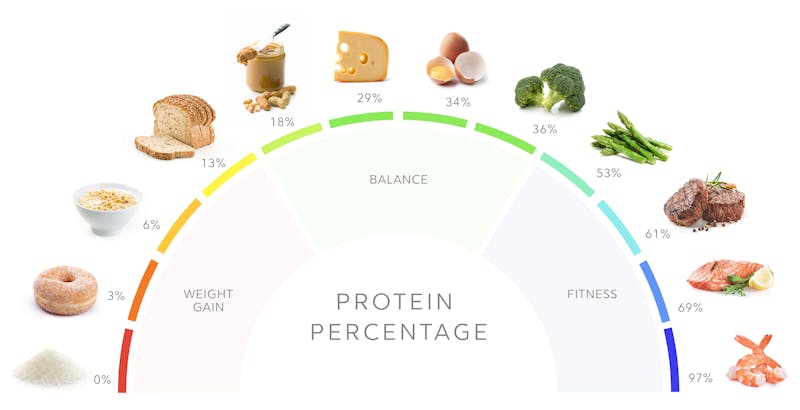As you age, getting the correct amount of protein, from the most healthy source is crucial to your health. That’s why I created this guide to help you navigate through all the information out there.
The older we get, protein becomes even more important because we begin to lose muscle mass as early as age 40. Protein also plays a vital role in the health of your hormones, sleep quality and weight loss. Made up of amino acids, protein also helps build our muscles, bones, cartilage, skin, hair, and blood. There are at least 10,000 different proteins that make you who you are.
So, how much is too much when it comes to protein? Because more protein doesn’t always mean better. And what type of protein should I eat? Protein needs differ based on your age and activity level so let’s dive i
:max_bytes(150000):strip_icc()/1-proteins-GettyImages-1131513408-43b934f1d0ec41279c01f73b4d0e4f56.jpg)
What Is The Best Protein
Not all protein is created equal. When you choose which foods to eat for protein, you should always consider the fats, fiber, and sodium that come with it.
A 6-ounce broiled porterhouse steak is very high in protein—about 40 grams worth. However, it also delivers about 38 grams of fat, 14 of them saturated. That’s more than 60 percent of the recommended daily intake for saturated fat. (yikes!)
Years ago, followers of the Atkins diet ate lots of red meat and dairy products to load up on protein. Many nutritionists became concerned about the amount of ingested saturated fat, lack of necessary nutrients, and lack of fiber. Unfortunately, all that red meat and saturated fat are linked to heart disease, but the ramifications of the Atkins school of thinking remain
You’d be much better off consuming protein from other sources. For example, eating the same 6 ounces of salmon gives you 34 grams of protein, but it’s under 18 grams of fat, 4 of them saturated.
A cup of cooked lentils has 18 grams of protein but under 1 gram of fat.
The Best Way To Get The Recommended Amount Of Protein
The best way to get the recommended amount of protein is through a balanced diet.
Protein can’t be stored in the body like fat and carbohydrates, so we need to replenish the supply every day. Yet the actual amount required may surprise people accustomed to caveman-sized steaks.
A chicken breast and a few handfuls of nuts supply all the protein that most healthy American adults need daily.

Protein Requirements By Age
The official recommended daily amount of protein for senior adults is 0.35 -. 5g for each pound of body weight per day, or about 55-75 grams of protein for a 150-pound person.
However, seniors over age 65 should consume 0.45 to 0.55 gram of protein per pound of body weight per day, or about 68 to 83 grams for a 150-pound person.
Some athletes will eat up to 1 gram of protein per pound for the best performance and health. (If you are trying to lose weight, base this calculation on your goal weight, not your current weight.)
What Are Good Sources Of Animal Protein?
The best animal protein choices are fish, poultry, eggs, and low-fat dairy.
If you love red meat, stick with the leanest cuts, choose moderate portion sizes, and make it only an occasional part of your diet.
What Are Good Sources Of Plant Based Protein?
You can get your protein from plant-based sources. Vegetarians do it every day.
Great plant protein sources include whole grains, nuts, seeds, sprouts, legumes, and organic soy foods.
Dark green, leafy vegetables, like kale, spinach, broccoli, asparagus, and peas, also have easily absorbed protein.
Sea plants such as algae, spirulina, and chlorella are filled with protein
And, of course protein powders can be an easy supplement.
:max_bytes(150000):strip_icc()/how-eat-proteins-2000-e47975aae0f44749b72d764aefb6d61b.jpg)
High Protein Foods
If you exercise and strength train regularly, you should know how much protein is in the foods you eat so that you can be sure to preserve and add muscle.
To assess how much protein is in the food you eat, here’s a reference guide with approximate amounts of protein per serving:
Beef
- Lean ground beef, 4 ounces – 28 grams of protein
- Steak, 6 ounces – 42 grams
Poultry
- Chicken breast, 4 ounces – 30 grams of protein
- Pork chop 4 ounces – 25 grams of protein
Fish
- Most fish fillets, 3.5 ounces – 22 grams of protein
- Tuna, 4-ounce pouch – 20 grams of protein
Eggs and Dairy
- Egg, large – 6 grams of protein
- Milk, 1 cup – 8 grams
- Cottage cheese, ½ cup – 15 grams
- Yogurt, 1 cup – 8-12 grams (Greek yogurt has about five more grams)
- Soft cheeses 6 grams per ounce
- Medium and hard cheeses (Cheddar, Parmesan) – 7 -10 grams per ounce
Beans (including soy)
- Tofu, ½ cup 10 grams protein
- Soy milk, 1 cup – 6 -10 grams
- Most beans (black, pinto, lentils, etc.) have about 7-10 grams of protein per half cup of cooked beans
- Soybeans, ½ cup cooked – 14 grams protein
- Peas, ½ cup cooked – 8 grams
Nuts and Seeds
- Peanut butter, 2 Tablespoons – 8 grams protein
- Almonds, ¼ cup – 8 grams
- Peanuts, ¼ cup – 9 grams
- Cashews, ¼ cup – 5 grams
- Pecans, ¼ cup – 2.5 grams
- Sunflower seeds, ¼ cup – 6 grams
- Pumpkin seeds, ¼ cup – 8 grams
- Flax seeds – ¼ cup – 8 grams
Vegetables:
- Spinach, 1-2 cups – 5.3 grams of protein
- Asparagus and broccoli 2 cups – 4.6 grams
- Collard greens and Brussels sprouts 2 cups -4 grams
- Green peas, 1 cup – 8.6 grams of protein